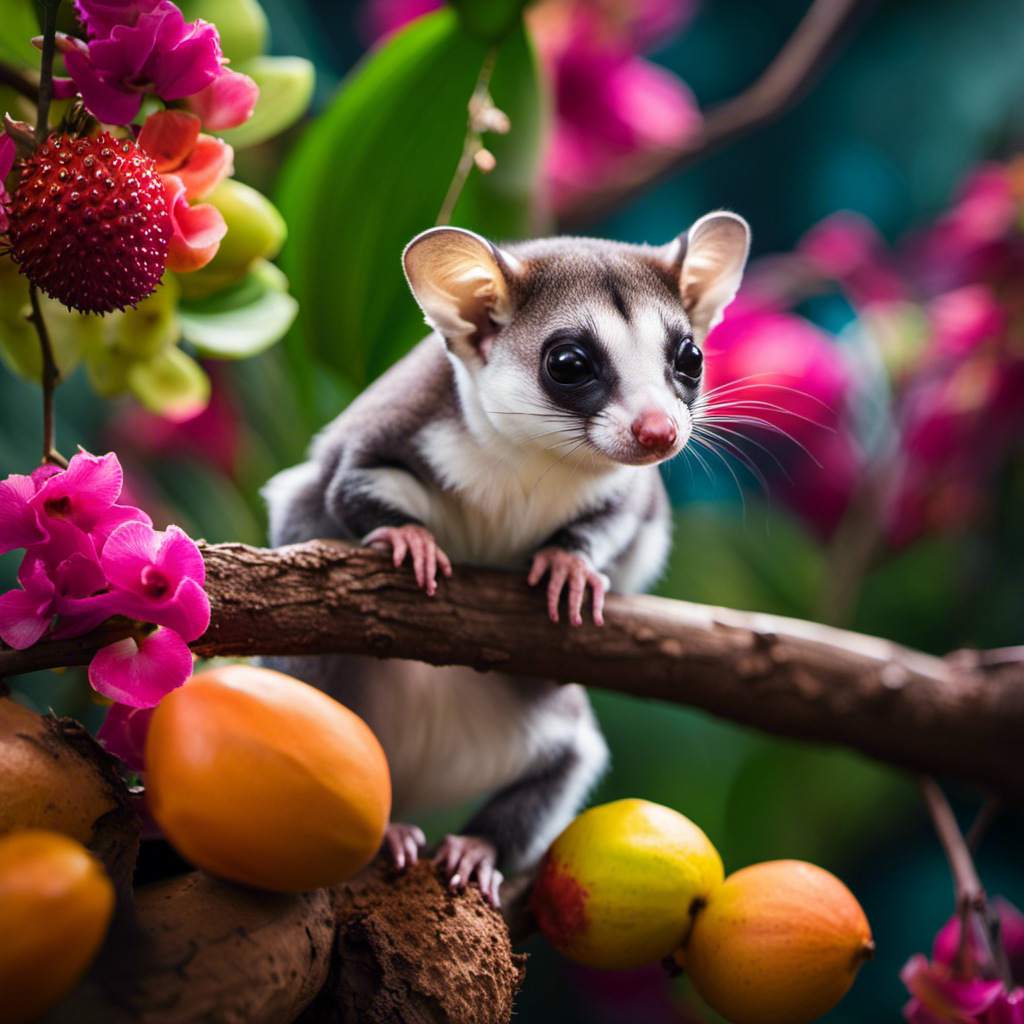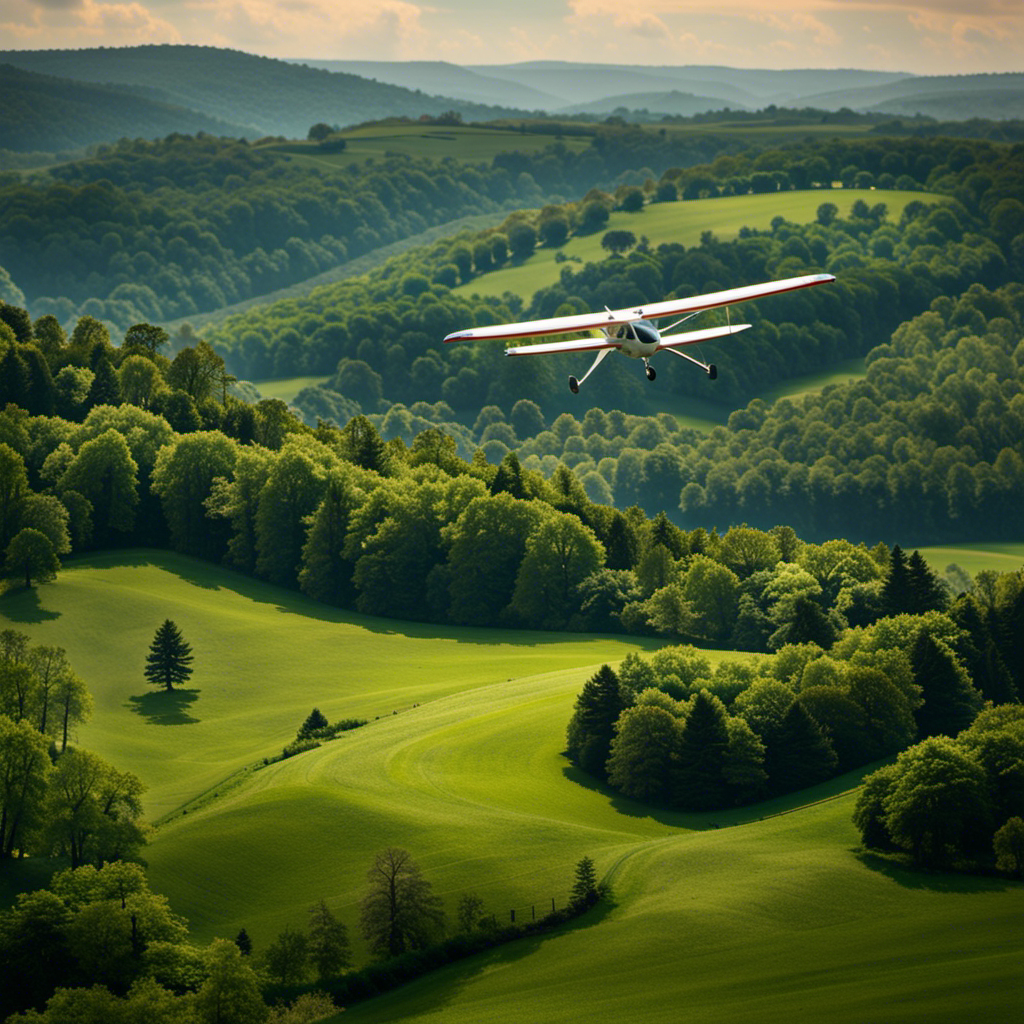Did you know that sugar gliders have a unique scent that sets them apart from other household pets?
In this article, I’ll explore the question, ‘Do sugar gliders smell?’ and provide you with scientific, objective information on managing their scent.
We’ll discuss the natural odor of sugar gliders, how to introduce them to your home, and the importance of bonding with these adorable creatures.
So let’s dive in and unravel the fascinating world of sugar gliders’ scent together.
Key Takeaways
- Scent plays a role in communication and bonding with other sugar gliders
- Sugar gliders have scent glands on their head, chest, and wrists that produce a musky odor for marking territory
- Scent helps identify individuals and convey information in sugar glider communities
- Understanding the significance of scent is important for comprehending sugar gliders’ social dynamics
Understanding Sugar Gliders’ Natural Odor
Sugar gliders do emit a natural odor, but it is not overpowering. Their scent glands, located on their head, chest, and wrists, produce a musky smell for communication and marking territory. You can minimize scent perception with proper hygiene and habitat maintenance. Regularly clean their cage, provide a balanced diet, and ensure fresh water. Keep their environment well-ventilated and use odor-absorbing materials to manage their scent.
Managing Sugar Gliders’ Scent
In order to manage the scent of sugar gliders, there are several key points to consider.
Firstly, regular cleaning and hygiene practices are essential to keep their living environment clean and odor-free.
Secondly, choosing the right bedding materials can help absorb and control any odors that may arise.
Lastly, using scent-neutralizing products can further assist in eliminating any lingering smells and keeping the area fresh.
Regular cleaning and hygiene practices
Make sure to regularly clean your sugar glider’s enclosure and practice good hygiene to keep them smelling fresh. Regular cleaning is essential for odor control and maintaining the overall health of your sugar glider.
Here are four important aspects to consider when it comes to regular cleaning and hygiene practices:
-
Remove waste and soiled bedding: Clean the enclosure daily, removing any waste or soiled bedding to prevent odors from building up.
-
Disinfect the enclosure: Use a pet-safe disinfectant to clean the enclosure thoroughly on a weekly basis. This helps eliminate bacteria and reduce potential odors.
-
Wash accessories and toys: Regularly wash your sugar glider’s toys, hammocks, and other accessories to prevent odor-causing bacteria from accumulating.
-
Maintain good personal hygiene: Wash your hands before handling your sugar glider and avoid using strong-smelling products, as they can transfer scents to your pet.
By following these regular cleaning and hygiene practices, you can help keep your sugar glider’s enclosure smelling fresh and clean.
Speaking of cleanliness, choosing the right bedding materials is another important aspect to consider.
Choosing the right bedding materials
To keep your sugar glider’s enclosure clean and fresh, it’s important to choose the right bedding materials. The type of bedding you use can have a significant impact on the odor emanating from the enclosure. There are several alternative bedding options available that can help reduce the smell. Here is a comparison table of three common bedding materials and their impact on odor control:
| Bedding Material | Odor Control Level | Absorbency Level |
|---|---|---|
| Paper-based | High | High |
| Wood shavings | Moderate | Moderate |
| Fleece liners | Low | Low |
As you can see, paper-based bedding offers the highest level of odor control and absorbency. Wood shavings and fleece liners, on the other hand, have a moderate to low impact on odor control. When choosing bedding materials, it’s important to consider not only the odor control but also the comfort and safety of your sugar glider. In the next section, we will explore the use of scent-neutralizing products to further enhance odor control without using harsh chemicals.
Using scent-neutralizing products
Using scent-neutralizing products can be an effective way to enhance odor control in your sugar glider’s enclosure. Scent neutralizing sprays are specially formulated to neutralize and eliminate odors, rather than simply masking them. These sprays contain enzymes that break down the molecules causing the odor, effectively eliminating it at the source.
When using scent neutralizing sprays, it is important to follow the instructions provided by the manufacturer and apply the product in a well-ventilated area. Additionally, consider other odor control methods such as regularly cleaning the enclosure, using odor-absorbing substrates, and providing proper ventilation. By incorporating these odor control methods, you can create a more pleasant environment for both you and your sugar glider.
Now, let’s discuss how to introduce sugar gliders to your home without causing them stress.
Introducing Sugar Gliders to Your Home
When introducing sugar gliders to your home, it’s important to create a safe and comfortable environment for them. This is especially crucial if you have children in the household. While sugar gliders can make great pets, it’s essential to educate your children about proper handling and care to ensure their safety.
Additionally, it’s important to be aware of potential health risks associated with sugar gliders. These adorable creatures can carry bacteria such as Salmonella, which can pose a risk to young children and individuals with weakened immune systems. It’s crucial to practice good hygiene, such as washing hands thoroughly after handling them or cleaning their cage.
Bonding with Your Sugar Glider
Creating a bond with your sugar glider is essential for a happy and fulfilling relationship. Bonding techniques play a crucial role in building trust between you and your pet. Here are some effective methods to foster a strong connection with your sugar glider:
| Bonding Techniques | Description | Benefits |
|---|---|---|
| Spend time together | Interact with your glider daily, allowing it to get used to your presence. | Establishes familiarity and comfort. |
| Offer treats by hand | Use treats to encourage your glider to approach you and associate you with positive experiences. | Strengthens positive associations and trust. |
| Carry your glider | Hold your glider close to your body in a bonding pouch to simulate the warmth and security of its natural habitat. | Enhances bonding through physical closeness. |
| Provide enrichment | Set up a stimulating environment with toys and activities to keep your glider engaged and entertained. | Promotes a happy and active relationship. |
| Be patient and gentle | Approach your glider calmly and handle it with care, respecting its boundaries. | Builds trust and creates a sense of security. |
Common Mistakes to Avoid
One common mistake to avoid when bonding with your sugar glider is rushing the process. Building trust and a strong bond takes time and patience. It is important to understand that sugar gliders are sensitive creatures and need to feel comfortable with their environment and their human companion.
Here are some common mistakes to avoid when bonding with your sugar glider:
-
Neglecting common hygiene practices:
-
Regularly cleaning the sugar glider’s cage, toys, and accessories.
-
Keeping their living space clean and odor-free.
-
Poor odor control:
-
Ensuring regular baths or dusting to control body odor.
-
Using appropriate bedding materials to minimize odors.
By avoiding these mistakes and focusing on proper hygiene and odor control, you can create a comfortable and pleasant environment for your sugar glider, which will contribute to a healthy and strong bond.
Moving on to providing a healthy diet, it is important to consider…
Providing a Healthy Diet
To ensure the health and well-being of your furry friend, it’s essential to provide them with a nutritious diet. Sugar gliders, like any other animal, require proper nutrition to thrive. Creating a balanced diet for your sugar glider involves offering a variety of foods that meet their specific dietary needs. Their diet should consist of a combination of fruits, vegetables, proteins, and supplements.
Fruits like apples and grapes provide essential vitamins and minerals, while leafy greens such as kale and spinach offer necessary fiber. It’s important to include a source of protein, such as cooked chicken or mealworms, to support their muscle development. Additionally, sugar gliders require supplements like calcium and vitamin D3 to maintain healthy bones. By providing proper nutrition, you can ensure your sugar glider stays healthy and happy.
Transition: Along with providing a healthy diet, regular veterinary care is vital for the well-being of your sugar glider.
Regular Veterinary Care
Transition: Now that we have discussed the importance of providing a healthy diet for sugar gliders, let’s shift our focus to another crucial aspect of their care: regular veterinary care.
-
Annual check-ups: Just like any other pet, sugar gliders should have yearly visits to the vet. These visits allow the vet to monitor their overall health and catch any potential issues early on.
-
Understanding dietary needs: A veterinarian experienced in exotic pet care can provide valuable guidance on the specific dietary needs of sugar gliders. They can recommend appropriate diets and supplements to ensure optimal nutrition.
-
Preventing dental issues: Sugar gliders are prone to dental problems, such as overgrown teeth. Regular dental exams and cleanings can help prevent these issues and ensure their dental health.
-
Vaccinations and parasite control: Vets can administer necessary vaccinations and prescribe parasite control treatments to keep sugar gliders protected against common diseases and parasites.
Transition: Now that we have covered the importance of regular veterinary care, let’s explore the next crucial aspect of sugar glider care: socialization and enrichment.
Socialization and Enrichment
Regular veterinary care is essential for sugar gliders’ overall health and well-being. In addition to regular check-ups, it is important to focus on socialization techniques and environmental enrichment for these adorable creatures.
Sugar gliders are social animals, so it is crucial to provide them with opportunities to interact with their owners and other gliders. This can be achieved through gentle handling, supervised playtime outside the cage, and the introduction of new toys and activities.
Environmental enrichment is also vital to keep sugar gliders mentally stimulated and physically active. This can include providing climbing structures, hiding spots, and foraging opportunities.
By implementing these socialization techniques and environmental enrichment strategies, we can ensure that sugar gliders lead fulfilling and enriching lives.
This leads us to the next section, where we will discuss educating others about sugar gliders’ scent and how it plays a role in their lives.
Educating Others About Sugar Gliders’ Scent
If you’re interested in educating others about sugar gliders’ unique scent, you can start by explaining how it plays a significant role in their communication and bonding with other gliders. Understanding scent glands and their behavioral factors is essential in comprehending the intriguing world of sugar gliders.
These small marsupials possess scent glands located on their heads, chest, and wrists. These glands produce a musky odor that is used for marking territory and identifying individuals. By rubbing their scent glands on objects and other gliders, they leave their mark and establish their presence. This scent serves as a form of communication, allowing gliders to convey information about their identity, reproductive status, and social hierarchy.
By educating others about these unique scent glands and their behavioral significance, we can better appreciate the complex social dynamics of sugar gliders.
In conclusion, embracing the unique scent of sugar gliders allows us to delve deeper into their captivating world of communication and social bonding. By understanding the role of scent glands and how they influence their behavior, we gain a greater appreciation for these fascinating creatures.
Next, we will explore the importance of proper diet and nutrition for sugar gliders, ensuring their overall health and well-being.
Conclusion: Embracing the Unique Scent of Sugar Gliders
To truly appreciate the captivating world of sugar gliders, take a moment to embrace their unique musky scent and delve deeper into their intriguing communication and social bonding.
While some may find their scent off-putting, it actually serves several important purposes for sugar gliders. Their scent glands, located on their chest and forehead, produce a distinctive odor that helps them communicate with other gliders.
This scent is used to mark territory, attract mates, and establish social hierarchies within their groups. Embracing the unique scents of sugar gliders allows us to better understand their complex social dynamics and the benefits of their scent.
Frequently Asked Questions
How often should I clean my sugar glider’s cage to minimize odor?
To prevent odor buildup in a sugar glider cage, it is important to clean it regularly. I recommend cleaning the cage at least once a week, removing any waste, replacing bedding, and disinfecting surfaces. This will help maintain a clean and odor-free habitat for your sugar glider.
Can I use scented products or air fresheners to mask the smell of my sugar glider?
Scented products and air fresheners may temporarily mask the smell of a sugar glider, but it’s important to note that these fragrances can be irritating to their sensitive respiratory systems. Regular cage cleaning and proper hygiene are more effective for minimizing odor.
Are there any specific foods that can help reduce the natural odor of sugar gliders?
Foods like apples, grapes, and vegetables can help reduce the natural odor of sugar gliders. These remedies work by improving their digestion and overall health, resulting in a less noticeable scent.
Can the scent of sugar gliders be harmful or irritating to humans?
The scent of sugar gliders can be irritating to some individuals, causing allergies and potential harmful effects. It is important for those with sensitivities to be cautious when interacting with these animals.
Are there any natural remedies or products that can help control the odor of sugar gliders?
Yes, there are natural remedies and odor control products available to help control the scent of sugar gliders. These can include specially formulated sprays, bedding materials, and regular cleaning routines to reduce odor buildup in their habitat.
Conclusion
In conclusion, embracing the unique scent of sugar gliders is truly a one-of-a-kind experience.
While some may find their natural odor overwhelming, I have come to appreciate it as a testament to their individuality.
The irony lies in the fact that what may seem like a flaw to some is actually a fascinating aspect of these incredible creatures.
So next time you think about sugar gliders and their scent, remember that it is just another way they distinguish themselves in the animal kingdom.
Embrace the aroma, and embrace the sugar glider.
Orion, better known as “Jetstream,” is the voice that brings the stories of the skies to life. His fascination with aviation began at a young age, sparked by his father’s tales of flying and adventure. Orion’s journey into the world of gliding was serendipitous, and from the moment he took his first glider flight, he knew he had found his calling.










